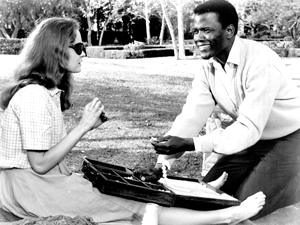Patch of Blue A (1965) – full review!
Patch of Blue A (1965) – full review!

Directed by Academy Award winning Cinematographer Guy Green (Great Expectations (1946)) who also adapted Elizabeth Kata’s novel "Be Ready With Bells and Drums" this above average drama features Shelley Winters’s second Best Supporting Actress performance (The Diary of Anne Frank (1959)). This time she plays the unsympathetic role of a white trash mother to a sightless 18 year old daughter played by Elizabeth Hartman (who earned her only Oscar nomination as Best Actress) whom she blinded! Sidney Poitier (Lilies of the Field (1963)) plays the man who befriends Hartman’s character and helps her to "see" a new life filled with wonder & kindness. Wallace Ford in his final role plays Hartman’s drunken grandfather who also lives with her and her horrible mother. The film’s B&W Art Direction-Set Decoration Robert Burk’s (To Catch a Thief (1955)) Cinematography and Jerry Goldsmith’s (The Omen (1976)) Score were also nominated.
The life & story of Selina D’Arcy (Hartman) is a sad one. She lives with a tramp of a cruel mother whom she calls by her first name Rose-Ann (Winters) and her alcoholic Ole (grand) Pa (Ford) in a small squalid apartment in the city. We learn later that she was blinded by her mother when her father came home early from a tour of duty to discover her with another man. In the fight that ensued Rose-Ann threw a bottle (of acid?) at her husband which missed him and blinded her five year old daughter Selina. To assuage her own guilt Rose-Ann then treats Selina as her personal slave keeping her out of school while making her their housekeeper and personal cook. Once Selina was even raped by one of her mother’s lovers. It is unclear why Ole Pa lives with them except perhaps because he has nowhere else to go and provides them some income. On a limited basis at least Ole Pa occasionally protects Selina from her mother’s rage and along with a neighbor provides Selina a means to "see" another world outside her awful home life. The neighbor played by an unrecognizable (yet prolific character actor) John Qualen provides Selina a means to earn her keep by hiring her to string beads for his business.
Selina lives for these days when she’s able to go to the park even though she generally just sits by a large tree and makes the bead necklaces. One day she meets quite by chance Gordon Ralfe (Poitier) a man who helps her get a caterpillar out of her blouse that had fallen down her back. Gordon soon learns of Selina’s condition lack of education and ignorance about virtually everything else. He is shocked to learn that even though she’s been blind for 13 years she doesn’t know how to read Braille or function in any but the simplest ways for a person in her situation. So he "adopts" her meeting her regularly at the park and helping her to experience life and all it entails. Though their relationship is entirely platonic it becomes a loving one that could lead to something more despite Gordon’s brother’s (Ivan Dixon) warnings that he’s not "seeing the forest for the trees". Through Selina Gordon learns that her family is racist; he’s yet to tell her his own race. Later Rose-Ann learns of Selina’s acquaintance with Gordon shortly after she had decided to change her daughter’s home environment even more drastically with her equally trashy friend Sadie (Elisabeth Fraser). The film’s ending is hopeful without being ridiculously and/or impractically sentimental.

